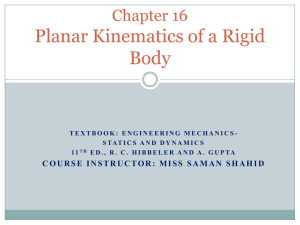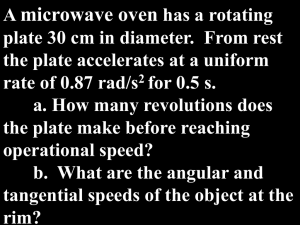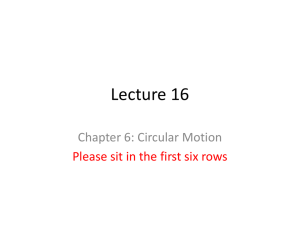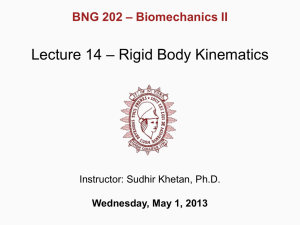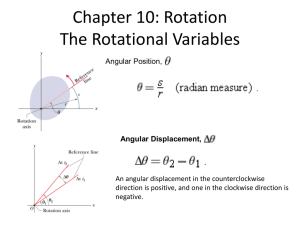File
advertisement
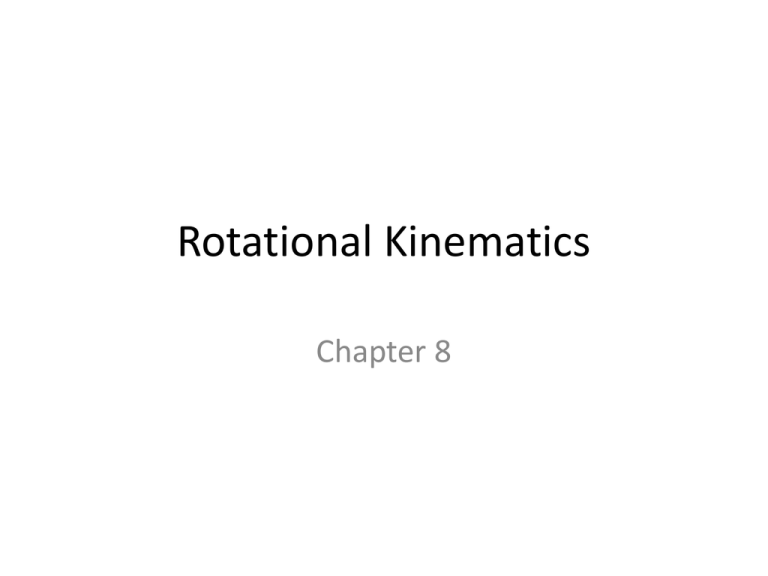
Rotational Kinematics Chapter 8 8.1 Rotational Motion and Angular Displacement • Axis of Rotation: the line all points on a rotating object rotate around. On a CD, it is an imaginary line through the hole in the center of the CD. • Angular Displacement: the angle ∆θ swept out by a line passing through any point and intersecting the axis of rotation perpendicularly. • Positive: counterclockwise • Negative: clockwise • SI Unit: radian (rad) Units, Units, and More Units • Degree: 360° in a circle • Revolution (rev): 1rev = 360° • SI and useful: radian arclength s Since s and r are both measurments of length, a radian is considered to be number without a unit radius r Converting Units • Remember: the arc length of an entire circle is the circumference 2πr • 1rev = 2πrad=360° 360 1rad 57.3 2 Read Conceptual Example 2 on pg. 225. Cool stuff really. 8.2 Angular Velocity and Angular Acceleration • SI Unit of angular velocity: rad/s • SI Unit of angular acceleration: rad/s2 - 0 t - t0 t Direction of angular velocity if positive when counterclockwise and negative when clockwise. For angular acceleration, the sign convention remains the same. 0 t t0 t Reminder: SAME CONCEPTS APPLIED TO A DIFFERENT TYPE OF MOTION OR SITUATION! THESE CONCEPTS SHOULD BE FAMILIAR! 8.3 The Equations of Rotational Kinematics Applying the Concepts The blades of an electric blender are whirling with an angular velocity of +375rad/s while the “puree” button is pushed in. When the “blend” button is pressed, the blades accelerate and reach a greater angular velocity after the blades have rotated through an angular displacement of +44.0rad. The angular acceleration has a constant value of +1740rad/s2. Find the final angular velocity of the blades. TRY THIS SELF ASSESSMENT TEST TOO! 8.4 Angular Variables and Tangential Variables • The tangential speed of any point rotating about a fixed axis represents the velocity vector which is tangent to that point on the circle. • The further from the axis of rotation for a given rotational velocity, the higher the tangential speed will be. Relating Angular and Tangential Variables Through Equations v T r When using this equation, ω MUST be in rad/sec because the equation was derived using these units! a T r Again, α must be in units of rad/sec2 !! The main difference between using angular and tangential equations is that the angular equations describe the entire object at one time but the tantential equations only describe one particular point of a moving object at any given time. Depending on the information given and needed, both will be useful. Centripetal Acceleration and Tangential Acceleration • Remember from previous chapters that when an object moves in a circle with a constant velocity, the centripetal acceleration will be pointed toward the center of the circle. • Substituting (rω) into the centripetal acceleration equation allows us to relate centripetal acceleration to tangential acceleration. ac r 2 Once again, use rad/s for ω! Putting it All Together • Discus throwers often warm up by standing with both feet flat on the ground and throwing the discus with a twisting motion of their bodies. Starting from rest, a thrower accelerates the discus to a final angular velocity of +15.0rad/s in a time of 0.270s before releasing it. During the acceleration, the discus moves on a circular arc of radius 0.810m. Find the magnitude (a) of the total acceleration of the discus just before it is released. 8.6 Rolling Motion • When an object is truly rolling, there is no slipping at the point of contact where the rolling object touches the ground. • If a tire makes one complete revolution (2πrad), the linear distance the center of the tire will have moved will be equal to the circumference of the wheel. v r a r 8.7 The Vector Nature of Angular Variables • So far, we haven’t discussed the vector direction of angular quantities. • When a rigid object rotates about a fixed axis, it is the axis that identifies the motion and the angular velocity points along the axis. • Right Hand Rule: Grasp the axis of rotation with your right hand, so that your fingers circle the axis in the same sense as the rotation. Your extended thumb points along the axis in the direction of the angular velocity vector. Vector Nature Continued • Angular acceleration has the same direction as the change in angular velocity. It will always point along the axis of rotation. • When the angular velocity is increasing, the acceleration vector points in the same direction as the angular velocity. • When the angular velocity is decreasing, the angular acceleration points in the direction opposite to the angular velocity. Final Notes • In this chapter, we “put things together.” In a sense, we have a more complete understanding of the motion of objects moving in circles. • Lots of new equations! UGGHH! Use an equation sheet when solving problems for HW. • Try both Chapter Assessments. The final one is linked below. • http://bcs.wiley.com/hebcs/Books?action=mininav&bcsId=3138&itemId= 0471663158&assetId=90800&resourceId=7780& newwindow=true


